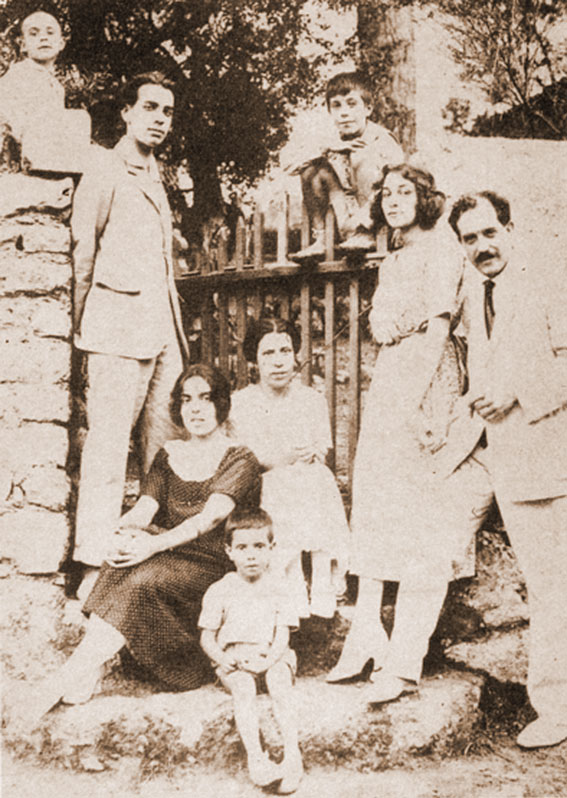The progressive lost of sight Borges’s father had took the family to an European pilgrimage. They first went to Geneva, where his illness would be treated, and stayed there throughout the Great War. The family will later establish in Mallorca and from there the inseparable Borges brothers went on to live in Seville for almost a year. While in Seville, Norah Borges and his brother Jorge Luis, engage actively in the Ultraist movement. It was then that his first works started to be published by magazines such as Grecia, Ultra y Reflector. In August of 1919, they would visit Córdoba. Their agenda included a rendezvous with the famous Córdoba painter Julio Romero de Torres.
Norah Borges –we shall talk about her in a future article– was a painter and an engraver and was eager to meet the painter. So the brothers went to his house and studio in the Plaza del Potro. Norah was astonished by the Córdoba painter’s work. She would later learn from Romero de Torres in Madrid, where the painter taught drawing at the School of Arts of San Fernando. She was a top student.
That was the first and last time Borges visited the city. To his regret, as he confessed in a late interview. He was asked, taking into consideration the numerous cities known by him, which one would he like to go to again, and to everyone’s surprise, Borges replied he would go back to Córdoba.
It is, if given a second thought, not that strange since one his best tales, “El Aleph”, portraits its history and characters and the Islamic era.
We find the first reference to Córdoba in the short-story “El Zahir” where a coin of little value is found by chance and would later become Borges’s Zahir. A Zahir is an Islamic notion, studied by the the theologian Córdoba Ibn Hazm, that accounts for the two faces of God, a sort of “Aladdin’s magic lamp” that allows and grants everything, even the sight of God. Borges would describe it using Córdoba as metaphor:
“In Guzerat, at the end of the XVIIIth century, a tiger was a Zahir; in Java, a blind man in the mosque of Surakarta stoned by the faithful; in Persia, the astrolabe that Nadir Shah commanded to be thrown into the sea; in the prisons of Mahdi, around 1892, wrapped in a shredded turban, a small compass touched by Carl Von Slatin; in the Aljama of Córdoba, says Zotenberg, a vein in the marble of one of the one thousand and two hundred piers; in the Jewry of Tétouan, the bottom of a well…”
There is second reference to Córdoba, here being a main element of the story, in “Averroes’s search”, also a part of “El Aleph”. In this short story Averroes is depicted trying to decipher two words by Aristotle unknown to him: Tragedy and Comedy.
At the beginning of the tale we find this beautiful paragraph describing the city:
“Deep in the nap, loving doves were loosing their voices; in some invisible courtyard the rumor of a fountain grew; something old in the flesh of Averroes, whose ancestors came from Arabic wastelands, thanked the perseverance of water. The gardens, orchards, remained below; there the busy Guadalquivir and then the dearest city of Córdoba, as clear as Baghdad or Cairo, like a complex and delicate instrument, in every direction beyond (and this Averroes felt it too) broadened across Spain, where there are few things but every one of them seems to stand in a substantial and long lasting manner.”
“Averroes’s search” is considered one of his best works. Though it might seem simple, the tale is of great depth. In 2003, during a conference in Rimini, within a cycle of lectures and insights on the classics that preceded the read of “Averroes’s search”, Umberto Eco said:
“Thus we go back to the Borges tale in which the Argentinian imagines Abulgualid Muhámmad Ibn-Ahmad Ibn-Muhámmad Ibn-Rusd determined to decipher and comment Aristotles Poetics. He worries that he might ignore the meaning of the words tragedy and comedy, read nine years earlier in the Rhetoric. And in deed it is so, as they were unknown artistic ways in the Arab tradition. While Averroes torments himself about the meaning of these obscure words, outside there are children imitating a Mu’adhin, a minaret and the congregation, that is, they are acting they are doing theater, but neither Averroes nor the children know it; that is the specific Borgesian feature. Later someone tells the philosopher about an strange ceremony seen in China and, by the description, the reader (however not the characters in the tale) understands that it is theater. At the end of this true and total misleading comedy, Averroes goes back to Aristotle and concludes that “Aristú… says tragedy when it is a panegyric and comedy when it is satires and anathemas. The Quran and the Mu’allaqat are rich in admirable tragedies and comedies. If there is a true apologetic text of misunderstanding between cultures, this would be it.”
Here you can read the full tale:
https://estoespurocuento.wordpress.com/2013/08/12/jorge-luis-borges-la-busca-de-averroes-cuentos/
Although if you prefer it to be told:

